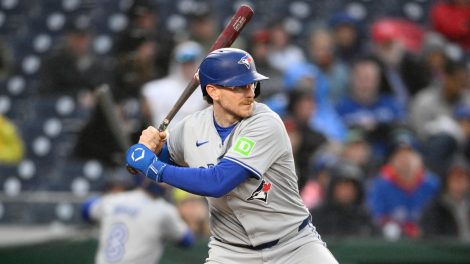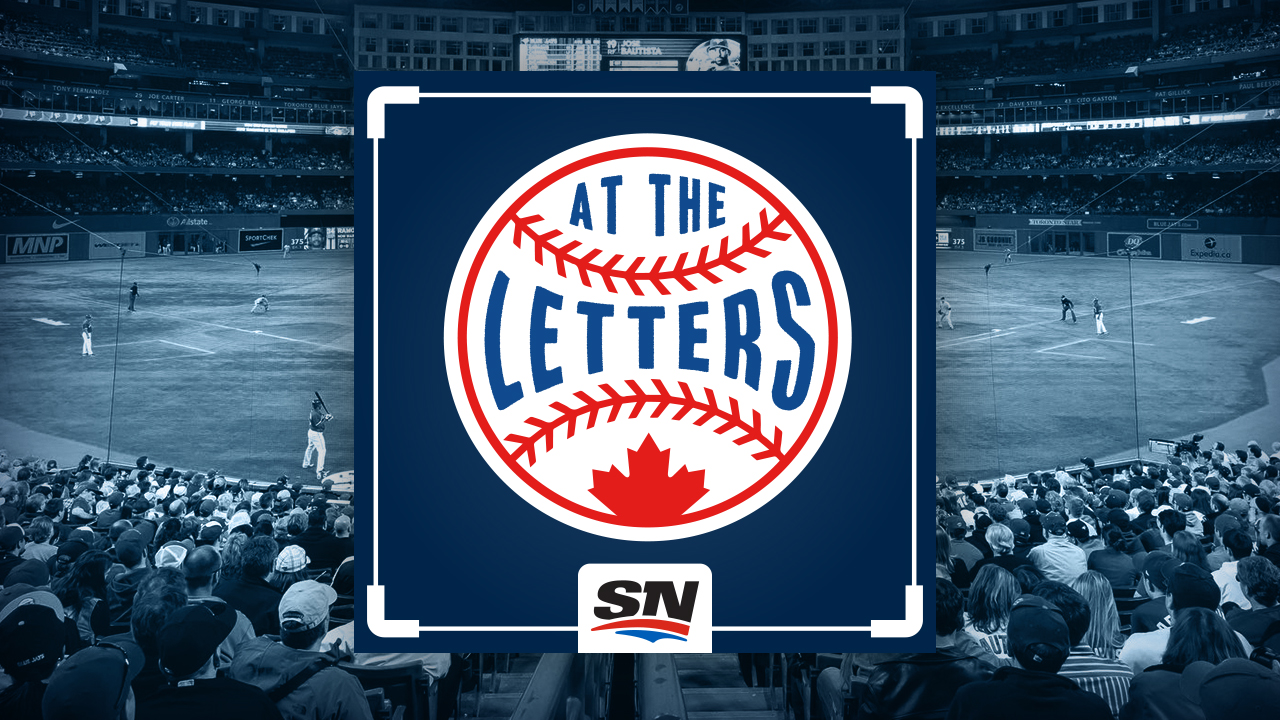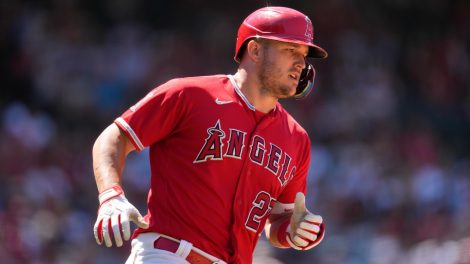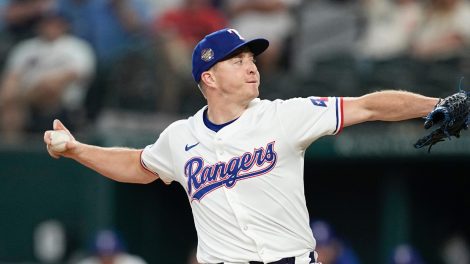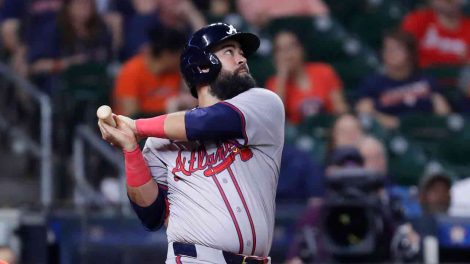CLEVELAND — Not sure if you’ve noticed, but the Toronto Blue Jays aren’t hitting. The 61 hits they’d mustered coming into Sunday’s game were the fewest over the first 10 games of a season in franchise history. The club’s .191 batting average, also a new low. Toronto’s 95 strikeouts through those 10 games paced MLB. More than half the league had yet to even reach 80.
It’s tough. But when you’re going through a prolonged cold spell like that, no matter what month it is, you try your best to keep things light. The last thing you want is for players to get so down on themselves, so consumed with the game’s inevitably high rate of failure, that it affects their performance even more negatively. A little levity never hurt.
So, about 45 minutes prior to Saturday’s game, someone pulled aside Jamey Rice, the team’s nutritionist and a contender for the least intimidating individual in the Blue Jays clubhouse, and asked her to give the team a fiery, impassioned, run-through-a-wall pre-game speech. She obliged. Although, when Brandon Drury suggested she smash one of his bats, it was a bridge too far.
Everyone had a good laugh at the unlikely aggression, and Blue Jays manager Charlie Montoyo suggested afterwards that if his team went out and scored 10 runs that afternoon, Rice would have to give her emotional address on a daily basis. Fortunately for her, the Blue Jays scored only two. Unfortunately for the team, that meant they lost for a sixth time in seven games.
Sunday, it became seven in eight, as the Blue Jays were swept out of Ohio with a 3-1 loss to the Cleveland Indians. The particulars were familiar. The Blue Jays got a solid outing from their starter, Marcus Stroman, who allowed three runs over six innings, striking out six. They also got little from their offence, which scored only six runs in the series. Toronto’s 19 hits in Cleveland tied for the second-fewest ever put up over a four-game series in the history of the franchise.
“I’m not going to insult your intelligence — our approach has not been good,” Montoyo said afterwards. “I’m not going to sugar coat it. It’s been really bad. But I promise you one thing, we’re going to frigging work on it. And we’re going to continue to work on it until we get out of this slump that we’re into right now.”
It’s a dramatic, nearly team-wide slump, and the fact that it’s occurring right at the beginning of the season is making it look, and feel, a lot worse than it is. Every team will go through a cold spell at one point or another. Before the season’s over, the Blue Jays will likely go through it again. But that doesn’t make it any easier.
Still, the team is doing what it can to counteract it. Blue Jays hitting coach Guillermo Martinez says he’s been encouraged by the positivity emanating from the team’s indoor hitting sessions, where veteran players like Justin Smoak and Freddy Galvis have been an important presence.
“I’m pretty sure people are thinking that the guys are feeling a lot of pressure, right?” Martinez said before Sunday’s game. “And they’re not. We’re in a good place. Especially guys like Smoak, Galvis — they’re talking to each other, talking to some of their younger teammates, helping them realize it is early, it’s going to happen. And it’s going to happen again somewhere down the line as well.
“We’ve practised our approach, we’ve talked about it. We do it every single day. The thing is just sticking to the plan. It’s really early. These guys are wanting to produce right away and make their season. That’s natural. But the last thing you want hitters to do is be up there searching for hits. We’ve just got to continue working hard and staying positive. As long as they keep grinding out at-bats, and swinging at good pitches to hit, results will come.”
The results no doubt will. The Blue Jays feature too many talented hitters with proven track records for them not to. The question is when. And the answer wasn’t Sunday.
[relatedlinks]
The Blue Jays didn’t manage a baserunner against Cleveland starter Mike Clevinger until Socrates Brito led off the fourth inning with a walk. Next up was Galvis, who’s been Toronto’s most reliable hitter this season. Like he did Thursday, when he broke up a no-hitter with a ninth-inning single, Galvis came up with Toronto’s first hit of the game, lacing a 97 m.p.h. fastball into right field for a double, putting two runners into scoring position with none out.
But that’s when things turned. First, Randal Grichuk struck out on three pitches. Then, Rowdy Tellez struck out chasing a fastball at his eyes. Finally, Teoscar Hernandez couldn’t catch up to a 98 m.p.h. heater on the inside black, stranding both runners. That was the start of 12 consecutive Blue Jays being retired, eight via strikeout.
“It’s not only the big hit. It’s just putting the ball in play. Hitting the ball up the middle so the guy can score,” Montoyo said. “We’ve got to make an adjustment, and I promise you we’re going to work on it. And we’re going to continue to work on it.”
Yes, strikeouts have been an issue. Sunday was the seventh time in 11 games that the Blue Jays struck out 10 times or more. They struck out 13 times or more in all four games of this series, a franchise record and only the fourth time that’s happened in the history of the sport.
It’s a difficult thing to contextualize in this three-true-outcome era when players are striking out more than ever. The record for MLB-wide strikeout rate has been raised each of the last dozen seasons, and 2019 was the first year in history in which there were more strikeouts than hits. And it’s not regressing. The current strikeout rate league wide (23.2 per cent) is nearly a full percentage point higher than 2018’s record.
Plus, the Blue Jays faced some exceptional pitching over their four days in Cleveland. Trevor Bauer, Carlos Carrasco, and Clevinger all finished among the top-15 starting pitchers in baseball last season in terms of wins above replacement, while Shane Bieber finished top-30 despite only pitching half a season. And all four of those pitchers finished with a K/9 north of 9.3.
“Those strikeouts are tough strikeouts against good pitching,” Martinez said. “We’ve just got to be better at hitting the fastball early. It’s not necessarily about trying to improve our two-strike approach. It’s more improving our pitch selection early in the count. If we don’t miss those early fastballs, we don’t get to two strikes.”
There’s certainly something to that, as the Blue Jays have been challenged by a steady barrage of breaking pitches this season. Coming into Sunday, 32.1 per cent of the pitches Blue Jays hitters had seen were breaking balls, the fifth-highest rate in the league. Meanwhile, Toronto’s .211 wOBA against those breaking balls was MLB’s fifth-lowest.
Of course, the Blue Jays aren’t trying to hit breaking balls. No team is. Everyone’s trying to hit fastballs. But facing a steady diet of curveballs and sliders can force hitters out of their tempo and rhythm at the plate. And then, when the fastball arrives, its tougher to execute against.
“Pitchers have definitely tested us with those breaking balls. It’s about being able to capitalize on the fastball when we do get it. We sit fastball. And we attack fastball. But that means we’re going to get those breaking balls,” Martinez said. “You’ve just got to play that game within the game.”
[snippet id=4545751]
Sunday’s eighth inning was a good example. The Blue Jays finally got a baserunner, a Billy McKinney leadoff double, and actually brought him in to score, when Danny Jansen went the other way for a one-out single two batters later. That put runners on the corners for pinch-hitter Lourdes Gurriel Jr., who whiffed wildly at a first-pitch slider in the dirt from Cleveland reliever Brad Hand.
Gurriel steadied from there, taking another slider for a ball before getting his fastball on the plate. And Gurriel hit it hard — the ball came off his bat at 105 m.p.h. But he also hit it on the ground, directly into an inning-ending double-play.
That’s the Blue Jays offence so far in a nutshell. Poor pitch selection at times, poor execution at others, good opportunities wasted in the process.
All the Blue Jays can do is believe they’ll eventually come out of it. And it’s at least worth noting they’re far from the worst-hitting club in the majors. Coming into Sunday’s games, eight clubs had fewer hits and runs scored on the season, including the Cleveland team that just beat them four times consecutively. Five clubs had a lower OPS and wRC+. Nine had a lower walk rate, while eight had a higher strikeout rate.
The Blue Jays also haven’t been particularly fortunate, as their .240 batting average on balls in play sat third-last in the league coming into Sunday’s game. The Blue Jays had MLB’s sixth-highest negative differential between their wOBA (.265) and xwOBA (.290), suggesting they’ve made much better contact than their results indicate.
But it’s those results that matter. And so far, the Blue Jays don’t have many good ones to point to.


